Chapter 1
for Sony’s breakthrough into digital audio technology.
As well as being a leader in consumer audio electronics, which are focused on enjoying music,
Sony has contributed to the field of music production over the years through their Professional Audio products.
Recently, Sony has introduced high-resolution studio condenser microphones and 360 Reality Audio, a new playback listening experience which allows for experiencing three-dimensional sound. The technologies that Sony has introduced in the world of professional audio through the years has been at the heart of many advances in music production itself.
In Chapter One, we would like to introduce you to some of the products that were established in the early days of Sony.
Owner of C-37As in the old Hit Factory Studios, New York City, and currently runs Germano Studios.

He talked about the C-37P and C-37B with us, and has worked with numerous big name Japanese artists such as Tatsuro Yamashita, Mariya Takeuchi, Junichi Inagaki, Eiichi Ohtaki, Minako Yoshida, Shogo Hamada, Seiko Matsuda, and many more.
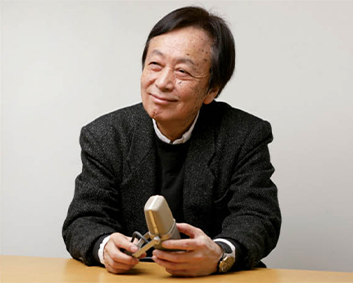
The first development in Japan of both the transistor
and a tape recorder, was done by Sony
In 1945, just after the end of the Second World War, a 37 year old electrician, Dai Ibuka, moved to Tokyo with his coworkers, including Akira Higuchi, and started a company called Tokyo Tsushin Kenkyujo, located in Nihonbashi. They were repairing and modifying radios and selling the converters for listening to shortwave broadcasts. The company had become popular and after they had been written about in newspapers, Akio Morita, whom they had known since the war, joined them, and Tokyo Tsushin Kogyo (a.k.a. Totsuko), which was the predecessor of Sony, was established in 1946.
Totsuko was producing vacuum tube devices and pickups used for analogue records, as well as various home appliances, but the epoch-making product was their tape recorder which was the first to be produced in Japan. Starting from research and development of magnetic tape, and through several prototype versions, Sony released a model called the GT-3 in 1950. This tape recorder was priced at around $450 (at the current exchange rate and dollar value at the time), which was considered quite expensive. As well, the chassis was fairly large, and was also quite heavy. This first model led to further development and the release of a more compact version in the following year. This newer version was accepted well in the education market and was installed in many schools and classrooms.
In order to aid research and deepen the knowledge of how tape recorders were being used, Ibuka then visited the United States. What he was also very interested in was the production of transistors, as back then, these new semiconductors were just being developed in the United States. Totsuko then made a challenge and succeeded in releasing the first domestically produced transistors in 1954. In the very next year ,1955, the first transistor radio in Japan, the TR-55 was released. Around this time, the trademark “Sony” was made as a method for improving the selling of Sony shares in the U.S. market. Achieving great success in making their way into the U.S. market with the small TR- 63 radio in 1957, the name of the company was officially changed to “Sony” in 1958.
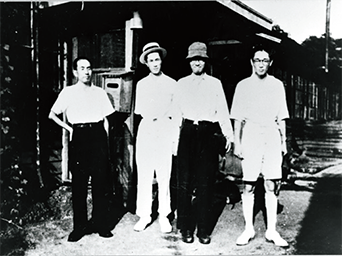
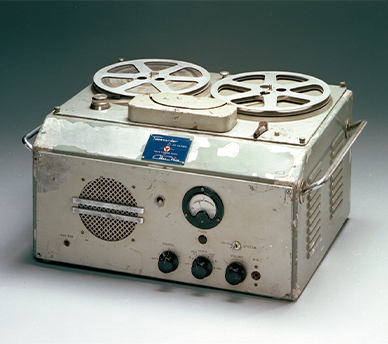
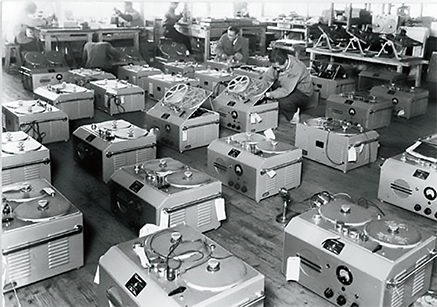
1 : The founding members of Tokyo Tsushin Kogyo, the predecessor of Sony. The picture was taken in front of the factory at Gotenyama, Shinagawa ward. Akira Higuchi, Kazuo Iwama, Dai Ibuka, and Akio Morita (From left to right).
2 : GT-3, released in 1950, became the first Japanese domestic tape recorder, also known as the “G model”, named from the research and development of magnetic tape that was also done within the company. At the time, the magnetic compound was painted on paper tape. This unit was priced at about $450 and weighed 35 kg. Originally targeted towards the general public, but to make it more affordable, the more compact H model was released in 1951.
3 : Production process of the GT-3
C-37A Tube condenser microphones
were also used in studios in New York City.
The development of magnetic tape and tape recorders were the foundations of Sony’s digital multi-track recorders, as were the development of AD and DA converters. The first professional audio product made by Sony was the C-37A tube condenser microphone. The development was led by Kaname Nakatsuru, and was started by referencing German microphones, but Nakatsuru struggled with designing the diaphragm. Receiving advices from Ibuka, and with the use of American made polyester films, he finally produced a gold vapor deposited diaphragm. Back in 1958, the newly released C-37A initially became popular in use for filming television programs. Gradually they were also used in music recording, and started to be used internationally, as well as just in Japanese domestic studios.
“I had felt something special with the C-37A” states Troy Germano who currently runs Germano Studios, also known for running the old The Hit Factory in New York. When he had started his career at The Hit Factory in 1975, he states that C-37As were already used routinely in the studio.
“The Sony C-37A microphones were used predominantly on horn/brass sessions throughout the '70s, 80s & 90s - this was definitely the “go to” microphone pair for horn recordings. I believe in 1975, Sony's impact on the professional audio manufacturer market was still in their early, formative years.”
We’ll talk about the 1980s and Sony in later chapters, but after the C-37A, Sony released the C-37P and C-38B microphones. Tamotsu Yoshida, a recording engineer who had worked with top Japanese artists such as Tatsuro Yamashita, Mariya Takeuchi, Junichi Inagaki, Eiichi Ohtaki, Minako Yoshida states as follows.
“I have used the C-37P since the beginning of my studio career. Compared to foreign microphones it had a clear sound and felt somewhat unaffected. I believe it is normally either the signal path of a console or the outboard gear which gives character to the sound, so I feel it would be better to have very “straightforward” sounding microphones. Of course, though, this is a very personal opinion. Also, the C-38B has very high clarity in its sound. Perhaps since we had driven the microphone by installing a 006P 9V battery, rather than a phantom power supply, that ended up in yielding less texture. Also, the diaphragm was mid-sized and that had led to getting less popping sound, and made the microphone quite useful. Although it had a cardioid pickup pattern, a relatively larger area was covered and that may have contributed to the reason why it was also accepted for the recordings of jokes and comedy talk sessions.”
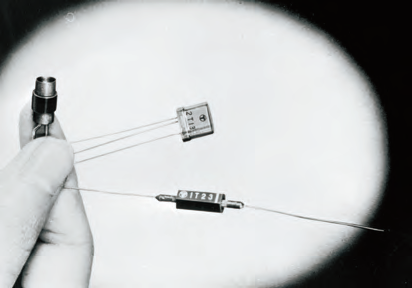
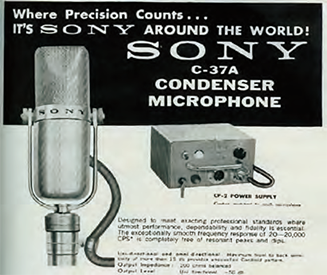
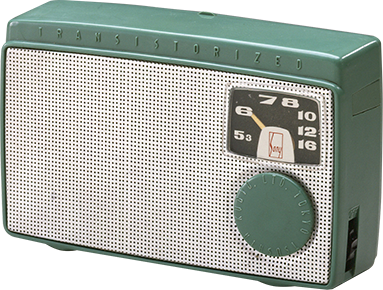
1 : The first domestically produced transistor and germanium diode produced by Tokyo Tsushin Kogyo. In the upper left is a point-contact transistor, while the upper right is a junction transistor. The lower right is a diode.
2 : An advertisement for the C-37A. The first domestically produced tube condenser microphone released in 1958. This was built with a gold vapor deposited polyester film diaphragm and 6AU6 pentode tube. This microphone still has quite a large number of fans, even today.
3 : The first domestically produced transistor radio, the TR-55 released in 1955. At the time, stationary tube radios were dominant, whereas the TR-55 was small enough to be portable, and was quite innovative.
The C-38B recorded the true sound of
Eiichi Ohtaki and Junichi Inagaki, just as they were.
About the use of the C-38B, Yoshida recalls “the main purpose, for me, was to record the vocal of Eiichi Ohtaki”
“Ohtaki was using a C-38B since the 1970s, when he had lived in Fussa. His album “A LONG VACATION” was fully recorded with the C-38B used on vocals, as I believe he had liked it so much. Since his voice had a very clear tone, the ability to capture it precisely may have made it work well. Later, I was assigned to work on the recording with Junichi Inagaki, and I remembered that Ohtaki had loved using the C-38B, which made me wonder if it would work well with Inagaki, too, as his voice also had a clear tone. So, basically, we had started using this microphone for vocal recordings, but at some point, I had joked and said, “What about recording the drums with all C-38Bs?” and it really happened (laugh). In fact, when we did it, we noticed that it produced a glossy sound. Probably one of the reasons was due to a richer high-end, as compared to a dynamic mic.”
At the time, Sony had focused on developing and introducing to the professional audio scene, mics that could capture audio ‘true to the original sound’, which seemed different from foreign condenser microphones. This could be stated as a result supported by Sony’s precise analog technologies.
In the next chapter, we will take a look into Sony’s Pro Audio history from the late 1970s, in which they stepped into the digital world...!


1 : C-37P FET condenser microphone. Loaded with an -8dB PAD and three types of low-cut functions, with various gradients.
2 : C-37B FET condenser microphone which can also be driven by a 006P battery. As well, the C-37P also has an -8dB PAD and multi-mode low-cut function, as well as a 5 kHz high-cut function. Released in 1970, it sold surprisingly well, and many continue to be sold, even today.

